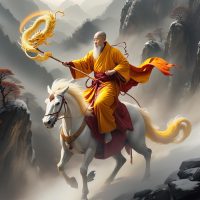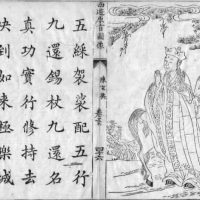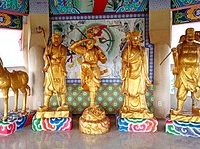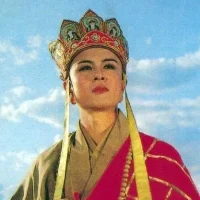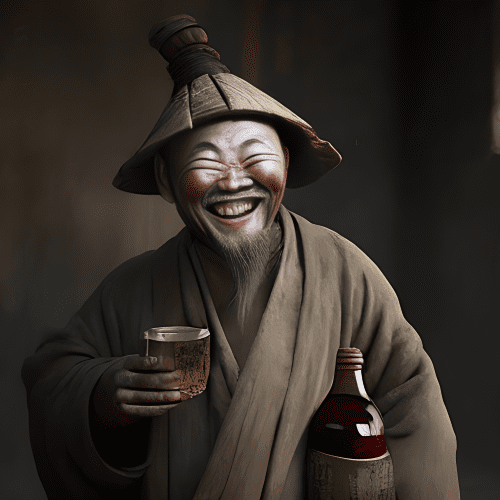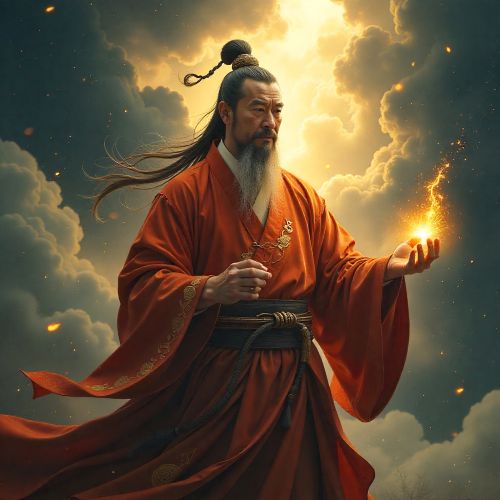Tang Sanzang : The Monk of the Journey to the West
Listen
At a glance
| Description | |
|---|---|
| Origin | Chinese Mythology |
| Classification | Mortals |
| Family Members | N/A |
| Region | China |
| Associated With | Traveling |
Tang Sanzang
Introduction
Tang Sanzang, also known as Tripitaka, is one of the most revered figures in Chinese mythology and Buddhist literature. Immortalized in the 16th-century classic Journey to the West by Wu Cheng’en, he stands as a symbol of piety, moral endurance, and the relentless pursuit of enlightenment. Based on the historical monk Xuanzang (602–664 CE), who journeyed from China to India to retrieve sacred Buddhist scriptures, Tang Sanzang’s mythic counterpart embodies the spiritual quest for truth and salvation. His pilgrimage across vast deserts, mountains, and demonic realms is both a literal and allegorical journey, representing humanity’s struggle to overcome ignorance and desire through faith and wisdom.
Physical Traits
Tang Sanzang is traditionally portrayed as a serene and youthful monk, embodying purity and divine purpose. Artists often depict him wearing flowing saffron or maroon robes, the color symbolizing spiritual dedication and renunciation of worldly attachments. He carries a khakkhara staff, which announces his presence to avoid harming living beings, and a begging bowl as a sign of humility. On his head, he often wears a beaded crown or golden fillet that signifies his disciplined mind. His constant companion is a white horse—actually a dragon prince transformed into a steed—representing purity and loyalty. His gentle expression and tranquil demeanor emphasize his compassion and moral clarity, distinguishing him from his more impulsive companions. Despite lacking physical power, Tang Sanzang’s aura of serenity and inner conviction make him a figure of immense spiritual strength.
Family
In the mythological narrative, Tang Sanzang’s origins intertwine tragedy and destiny. Born as the posthumous son of Chen Guangrui, a high-ranking scholar, and Lady Yin Wenjiao, his early life was marked by hardship. His father was murdered through political treachery, and his mother, forced into hiding, sent the infant adrift on a river in a wooden chest. The baby was rescued by monks at a monastery, who named him Jiang Liu, meaning “River Current.” Raised in the monastic order, he displayed exceptional devotion and intellect from a young age. Upon ordination, he adopted the Dharma name Xuanzang and was later bestowed the royal surname “Tang” by Emperor Taizong, marking him as a representative of the Tang Empire on his sacred mission. His divine lineage further deepens his character: he is believed to be the reincarnation of the Golden Cicada, a celestial disciple of the Buddha punished for neglecting his spiritual duties, destined to redeem himself through his earthly pilgrimage.
Other names
Tang Sanzang is known by several names, each reflecting a different aspect of his identity. “Tang” associates him with the Tang dynasty, emphasizing his role as an emissary of both his empire and the Buddhist faith. “Sanzang” translates to “Three Baskets,” referring to the Tripitaka—the three major categories of Buddhist scriptures: Sutra, Vinaya, and Abhidharma. The Sanskrit term “Tripitaka” is also used as an honorific for devout monks deeply versed in Buddhist teachings. His historical identity as “Xuanzang” highlights his scholarly achievements and his real-life pilgrimage from Chang’an to Nalanda. In his celestial aspect, he is “Golden Cicada” (Jīnchánzi), symbolizing rebirth and spiritual metamorphosis. Collectively, these names convey his multifaceted nature—as a historical scholar, spiritual pilgrim, and divine emissary of enlightenment.
Powers and Abilities
Although Tang Sanzang lacks martial skills, his strength lies in his profound spirituality and moral conviction. His purity of heart is so absolute that demons believe consuming his flesh grants immortality, making him both a target and a symbol of divine sanctity. His spiritual authority commands respect among gods and mortals alike. Gifted by the bodhisattva Guanyin with the Tight-Fillet Spell (Jingūzhòu), he can control the impulsive Monkey King, Sun Wukong, through a sacred chant—demonstrating the triumph of discipline over chaos. His mastery of Buddhist sutras allows him to recite scriptures capable of dispelling evil, healing suffering, and invoking divine protection. His unwavering compassion enables him to tame his companions—Pigsy and Sandy—not through force but through kindness and moral guidance. Tang Sanzang’s greatest ability is his steadfast faith, which transforms obstacles into lessons and enemies into allies.
Modern Day Influence
Tang Sanzang’s legacy continues to resonate across cultures, religions, and artistic forms. The historical Xuanzang’s journey profoundly influenced Buddhist philosophy by introducing key Mahayana texts to China and establishing the Consciousness-Only (Yogachara) School, which reshaped East Asian Buddhism. In the realm of literature and popular culture, Journey to the West remains one of the most influential works in Asia, inspiring adaptations across film, television, and animation. The 1986 Chinese TV series Xi You Ji set a cultural benchmark, while modern retellings like Stephen Chow’s Journey to the West: Conquering the Demons (2013) and The Monkey King films reinterpret Tang Sanzang as a dynamic moral figure navigating faith in a modern world.
Beyond Chinese borders, the monk’s archetype has appeared in international works, including Japanese manga and anime such as Saiyuki, where Tang Sanzang is reimagined as a warrior-priest traveling with supernatural allies. Video games like Smite and The God of High School feature him as a mystical healer or divine tactician, translating his compassion and intellect into digital heroism. His pilgrimage has even been studied as a symbol of early intercultural exchange between China and India, embodying themes of peace, perseverance, and cross-cultural dialogue.
Today, Tang Sanzang’s name evokes not only the spiritual discipline of a monk but also the enduring power of knowledge and compassion in a turbulent world. His story continues to remind audiences that enlightenment is not achieved through conquest, but through understanding, sacrifice, and faith—a message as relevant in modern society as it was on the ancient road to the West.
Related Images
Source
Wu Cheng’en. (1592). Journey to the West. Ming Dynasty Literature Archive.
Wikipedia contributors. (2024, August 26). Tang Sanzang. Wikipedia. https://en.wikipedia.org/wiki/Tang_Sanzang
Asia Society. (2017, July 24). Xuanzang: The monk who brought Buddhism East. https://asiasociety.org/xuanzang-monk-who-brought-buddhism-east
Journey to the West Research. (2018, May 26). Tripitaka and the Golden Cicada. https://journeytothewestresearch.com/2018/05/26/tripitaka-and-the-golden-cicada
Goodmany Activities. (2023). Tang Sanzang and Sino-Indian cultural exchange. https://www.goodmanyactivities.com
The Demonic Paradise Wiki. (2007). Tang Sanzang. Fandom. https://the-demonic-paradise.fandom.com/wiki/Tang_Sanzang
Smite Amino. (2023, January 24). Tang Sanzang: Buddha’s Messenger. https://aminoapps.com/c/smite/page/blog/tang-sanzang-buddhas-messenger/kwwB
Yu, A. C. (1977). The Journey to the West. University of Chicago Press.
Dudbridge, G. (1970). The Hsi-yu chi: A Study of Antecedents to the Sixteenth-Century Chinese Novel. Cambridge University Press.
Teiser, S. F. (1994). The Ghost Festival in Medieval China. Princeton University Press.
Wang, D. (2004). The Monster That Is History: History, Violence, and Fictional Writing in Twentieth-Century China. University of California Press.
Frequently Asked Questions
Who is Tang Sanzang in Journey to the West?
Tang Sanzang is a devout Buddhist monk chosen by the Tang emperor and the heavens to travel west and retrieve sacred scriptures for China.
What does the name “Sanzang” mean?
“Sanzang” translates to “Three Baskets”, referring to the three categories of Buddhist scriptures he is destined to recover.
Is Tang Sanzang based on a real person?
Yes. His character is inspired by the historical monk Xuanzang, who traveled to India in the 7th century to bring back original Buddhist texts.
Why is Tang Sanzang protected by disciples like Sun Wukong?
He is vowed to non-violence, so powerful guardians accompany him to defend him from demons who seek to capture him and gain immortality.
What does Tang Sanzang represent in the story?
He symbolizes purity, compassion, and unwavering faith, guiding his companions morally even when they face spiritual challenges.


